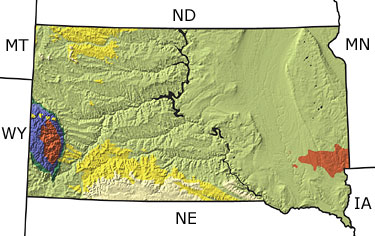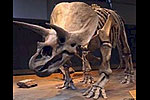Paleontology and geologyThe Precambrian: Precambrian rocks are exposed in the Black Hills in the western part of the state and in the Sioux Arch in eastern South Dakota. All of these rocks are metamorphic; no fossils have been found in them to date.
The Paleozoic: A shallow sea flooded South Dakota in the early Paleozoic, depositing a sequence of progressively finer-grained layers of sediment. Trace fossils are abundant in the Cambrian rocks of the state. Fossils of corals, brachiopods, cephalopods, and other invertebrates indicate that marine conditions continued through the early to middle Paleozoic, interrupted by brief intervals during the Ordovician when the sea withdrew, leaving the state exposed to erosion. The late Paleozoic (Carboniferous) was again a time of fluctuating sea levels across the state: fossils of brachiopods and corals, and the presence of evaporites and coal deposits, are evidence that marine, brackish, and fresh water conditions existed at various times through this interval. Sea level dropped during the Permian, once more leaving South Dakota exposed to erosion.
The Mesozoic: South Dakota was covered by humid coastal plains and intertidal mudflats during the early Mesozoic (Triassic). The sea again flooded the state in the middle Mesozoic (Jurassic), leaving behind a rock record that includes fossils of clams, ammonites, crinoids, and starfish. Lakes, swamps, and streams developed over the landscape as the sea retreated later in the Jurassic. The sedimentary rocks formed in these environments contain abundant plant fossils and the remains of giant sauropod dinosaurs. During the late Mesozoic (Cretaceous), a great seaway developed, once more covering much of South Dakota with marine waters. This seaway was home to abundant invertebrates, marine reptiles, and aquatic birds, while dinosaurs, small mammals, and birds inhabited the shores and inland areas. The Black Hills of western South Dakota were uplifted during this time.
The Cenozoic: The Black Hills continued to rise during the early Cenozoic (Tertiary), while the last invasion of marine water over South Dakota occurred in the central and eastern parts of the state. As the Cenozoic progressed, the sea gradually withdrew from the state and was replaced by expanding grasslands inhabited by numerous grazing mammals. Layers of ash incorporated in early Cenozoic rocks across the state indicate that this was a time of volcanic activity. In the late Cenozoic (Quaternary), ice sheets advanced and retreated across South Dakota. Gravels and sands left behind by the melting ice contain numerous fossils of bison, mammoth, mastodon, and horse. Erosional processes increased during the Late Quaternary and continue to modify the surface of South Dakota today. |

